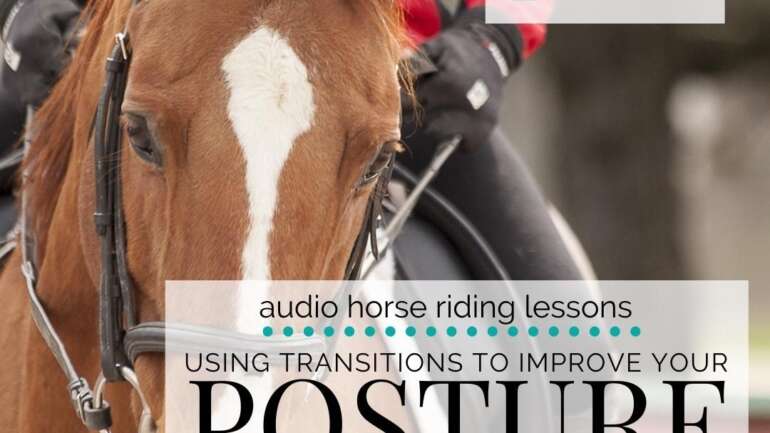For many riders, posture is something that they rarely think a whole lot about. It’s a basic that you ‘set and forget’. Meaning, you figure out what it is and how it feels, and then you are diligent in putting it onto autopilot. Which then frees you up to focus on other things. And this works well; until it doesn’t…
Transitions, particularly between gaits, have this special ability to shine a spotlight on any weaknesses either horse or rider has, and riders posture is often the focus of this attention
However, transitions by their very nature can also be a really useful tool to help riders overcome any posture challenges. They require you to engage and carry yourself. And they also continually question you by requiring balance throughout the movement.
Here are a few ideas to help you make the most of using transitions to improve your posture…
Know What You Want Before the Transition
It seems so obvious but getting clear on exactly what you want to achieve beforehand will help. This means moving out of ‘autopilot’ and becoming present with regards to how you are using your body in the original gait. How does it feel through your shoulders and chest when you are carrying yourself? And your seat? What are your hands doing?
In order to improve something that you already have a habit of doing, you must first become self-aware. Use your time in the gait before the transition to assess your posture and correct any problems.
By becoming more self-aware, you will often notice where those bad habits are beginning to slip into your everyday riding. Maybe it’s a collapse of a shoulder through a bend or corner. Or perhaps a tendency to become heavy through your seat as you half halt. Whatever you notice, fix it inside of the gait first, before then moving on to working on it through the transitions themselves.
Practice in Walk and Halt
What if someone said that before you could trot, canter, or do any of the ‘fun things’ you love to do on a horse again, you first had to perfect your ability to walk? Many riders don’t think of the walk as being something that needs work, but this couldn’t be further from the truth. This is why I think investing time in your walk will help both you and your horse in the long run.
When you first begin actually using transitions to improve your posture work between walking and halting. Focus on being as consistent as you can within these two gaits, and only then, begin introducing trot to the mix.
Notice how well you can maintain both your posture, your position, and your positive tension throughout your body. All of the above will influence the horse through the transition, and help determine if the transition is a success or a little less than inspiring!
Positive Tension in Your Body
This is a key part of transitions. The energy needed to ride a transition is different from what’s being done both before and after the transition itself. And it can often be a struggle to find the correct level of tension – relaxation – through it.
There is also the responsibility of smoothing out the tension levels so that what came before blends with the transition and then smoothly continues into the new gait.
Riders who carry excess tension in their bodies through the transitions tend to lose their posture. They either become ‘contracted’ through certain parts of the body – for example, the arms and shoulders – or they ‘lean’. This will look like their shoulders are either in front of or behind their hips.
One of your goals as a rider, through all transitions, is the ability to find the correct level of tension and then blend that with what’s before and after the transition itself – and then help your horse to do the same.
Remain Aligned Through Your Body
Once you’re clear on what you want, you can now begin to practice this through different transitions. Pay attention to the alignment of your body. If you find, at any point, that you have lost that basic alignment, pause a second and try to figure out why…
Keep in mind that sometimes poor posture is a symptom of something else going on, perhaps position related. Find the root cause, and correct that first.
This will often result in your posture being more consistent, without you having to actually ‘fix’ anything regarding your posture. Self-carriage is a big part of posture, so if in doubt, lift yourself. Carry through your body, open your chest, and elongate or lengthen down through to the heel.
Using Transitions to Improve Your Posture
As I’ve mentioned, transitions are a great way to really highlight what’s going on in your body when you ride. By taking the time to really notice what you’re doing, you can often fast-track your progress in other areas.
Keep in mind, if your posture is letting you down through each transition, you are spending precious strides in each new gait trying to ‘fix’ that and re-establish what was lost.
Making ‘good posture’ a goal for you and your horse over the coming weeks and months will allow you both the space, literally, to begin implementing new things in your riding.
Happy Riding
Lorna

